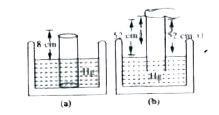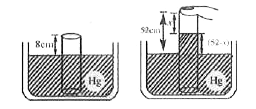The mercury manometer consists if two unequal arms of equal cross section 1 cm^(2) and lenghths 100cm and 50cm. The two open ends are sealed with air in the tube at a pressure of 80cm of mercurey. Some amount of mercury is now introduced in the manometer through the stopcock connected to it. If mercury rises in the shorter tube to a lenght 10cm in steady state, find the length of the mercury column risen in the longer tube.Solution in Tamil
Let and be the pressures in centimetre of mercury in the two arms ater introducing mercury in the tube. Suppose the mercury column rises in the second arm to.
using (80cm) (50cm)= p_(1)(50cm-10cm)
or, p_(1)=100cm Using pV=constant fir the longer arm,
....(ii)
From the figure,
.
Thus by (i)
.
Putting in (ii),
or,
or,.
The requrired length is

Topper's Solved these Questions
Similar Questions
Find the dimensions of
a. linear momentum
b. frequency and
c. pressure04:45View SolutionShould the internal energy of a system necessarily increase if heat is added to it?
05:55View SolutionThe heights of mercury surfaces in the tow arms of the manometer shown in figure are 2 cm and 8cm. Atmospheric pressure =1.01×105Nm−2 . Find a. the pressure of the gas in the cylinder and b. the pressure of mercury at the bottom of the U tube.
 06:04View Solution
06:04View SolutionAn open glass tube is immersed in mercury in such a way that a length of 8 cm extends above the mercury level. The open end of the tube is then closed and sealed and the tube is raised vertically up by additional 46 cm. what will be length of the air column above mercury in the above now ? (Atmospheric pressure = 76 cm of Hg)
06:19View SolutionA U shaped tube has two arms of equal cross section and lengths l_(1) = 80 cm and l_(2) = 40 cm. The open ends are sealed with air in the tube at a pressure of 80 cm of mercury. Some mercury is now introduced in the tube through a stopcock connected at the bottom (the air is not allowed to leak out). In steady condition the length of mercury column in the shorter arm was found to be 10 cm. Find the length of the mercury column in the longer arm. Neglect the volume of the part of the tube connecting two arms and assume that the temperature is constant.
06:05View SolutionAn open glass tube is immersed in mercury in such a way that a length of 8 cm extends above the mercury level. The open end of the tube is then closed and sealed and the tube is raised vertically up by additional 46 cm. what will be length of the air column above mercury in the above now ?
(Atmospheric pressure = 76 cm of Hg)View SolutionA manometer is connected to gas container. Then the mercury level rises by 2 cm in the arm of the manometer which is not connected to the container. If the atmospheric pressure is 76 cm of mercury, then the pressure of the gas is ________ cm of mercury.
View SolutionAn open glass tube is immersed in mercury in such a way that a length of 8 cm extends above the mercury level. The open end of the tube is then closed and sealed and the tube is raised vertically up by additional 46 cm. What will be length of the air column above mercury in the tube now? (Atmospheric pressrure = 76 cm of Hg)
View SolutionA glass tube open at both ends is immersed vertically in mercury in such a way that 13 cm length of the tube remains above the mercury surface. Now closing the upper end of the tube,it is raised through a further 35 cm. Determine the length of the air column above mercury in the closed tube. Atmospheric pressure =76 cmHg.
05:01View SolutionAn open pipe made up of glass is immersed in mercury in such a way that a length of 8 cm extends above the mercury level. The open end of the tube is then closed and sealed and the tube is raised vertically up by additional 46 cm. What will be length of the air column above mercury in the tube now?(atm pressure =76 cm of HG)
03:34View SolutionAn open glass tube is immersed in mercury in such a way that a length of 8 cm extends above the mercury level. The open end of the tube is then closed and sealed and the tube is raised vertically up by additional 46 cm. What will be length of the air column above mercury in the tube now ? (Atmospheric pressure = 76 cm of Hg)
05:22View SolutionThe heights of mercury surfaces in the two arms of the manometer shown in figure are 2 cm and 8cm. Atmospheric pressure =1.01×105Nm−2 . Find (a). the pressure of the gas in the cylinder and (b). the pressure of mercury at the bottom of the U tube.
 View Solution
View SolutionAn open glass tube is immersed in mercury in such a way that a length of 8 cm extends above the mercury level. The open end of the tube is then closed and sealed and the tube is raised vertically up by additional 46 cm. What will be length of the air column above mercury in the tube now? (atmospheric pressure =76 cm of Hg)
View SolutionAn open glass tube is immersed in mercury in such a way that the length 8 cm extends above the mercury level. Now the open end of the tube is closed by a finger and raised by further by 44 cm. What will be the length of air column above mercury in the tube. Take atmospheric pressure to be 76 cm of mercury. Neglect capillary effect.
View SolutionAn open glass tube is immersed in mercury in such a way that the length 8 cm extends above the mercury level. Now the open end of the tube is closed by a finger and raised further by 44 cm. What will be the length of air column above mercury in the tube. Take atmospheric pressure to be 76cm of mercury. Neglect capillary effect.
 View Solution
View SolutionAn open glass tube is immersed in mercury in such a way that the length 8 cm extends above the mercury level. Now the open ,end of the tube is closed by a finger and raisedfurlher by 44 cm. What will be the length of air column above mercury in the tube. Take atmospheric pressure to he 76cm of mercury. Neglect capillary effect.
 03:17View Solution
03:17View Solution

